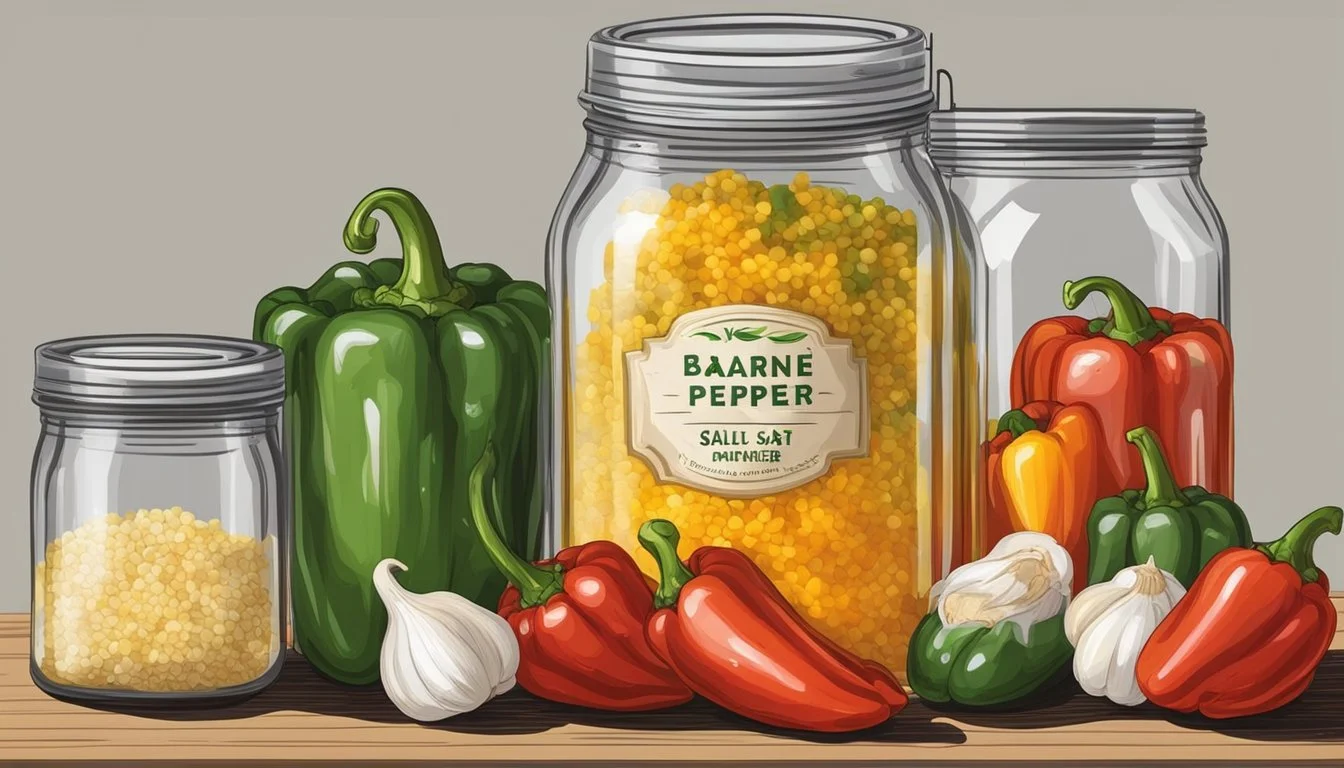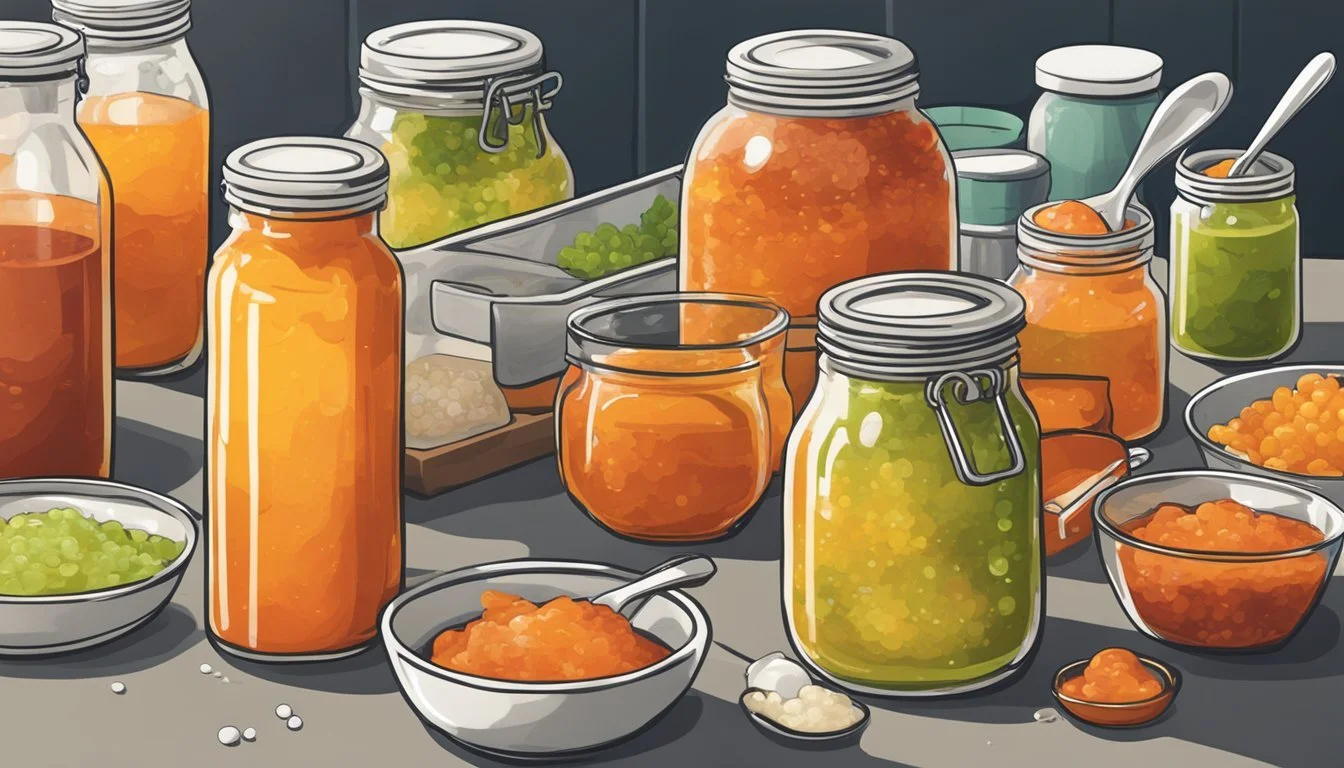How to Ferment Lacto-fermented Hot Sauces
A Step-by-Step Guide
Lacto-fermented hot sauce is a condiment that achieves its distinctive flavor and preservation through the process of lacto-fermentation. This method uses beneficial lactic acid bacteria, found naturally on the surface of vegetables, to ferment the sauce in a controlled environment. As the bacteria consume sugars and convert them to lactic acid, the pH of the sauce drops, effectively preserving the sauce and developing a complex, tangy taste profile. This ancient technique not only enhances the flavor of the hot sauce but also imbues it with potential health benefits, as lacto-fermentation can increase the bioavailability of nutrients and introduce probiotics, which are believed to support gut health.
Making lacto-fermented hot sauce starts with fresh peppers, which can range from mild to intensely hot varieties depending on personal preference, and often includes additional ingredients like garlic (What wine goes well with garlic?) for depth of flavor. The peppers—and any other vegetable additions—are typically prepped by washing, chopping, and sometimes deseeding, then combined with a brine solution composed of water and salt. The precise salt concentration in the brine usually hovers around 2% to 5%, a crucial detail that helps ensure the correct environment for lacto-fermentation and inhibits the growth of unwanted bacteria.
The mixture is then sealed in an air-tight container, often a glass jar, and left to ferment at room temperature, away from direct sunlight. Over the course of several days to a few weeks, the sauce undergoes a transformation as the bacteria produce lactic acid, which not only preserves the sauce but also imparts the distinctive, tangy taste that fermented hot sauces are known for. As the fermentation period ends, the sauce is typically blended to the desired consistency and can then be enjoyed immediately or further aged for a more developed flavor profile.
Understanding Lacto-Fermentation
Lacto-fermentation is a culinary practice that not only preserves foods but also enhances their nutritional value through the action of beneficial bacteria. This ancient method harnesses the power of naturally occurring lactic acid bacteria to create tangy, complex flavors while contributing to gut health.
Fundamentals of Fermentation
Lacto-fermentation begins when lactobacillus bacteria convert sugars present in food into lactic acid. This process not only imparts a distinctive sour taste but also acts as a preservative by lowering the pH and creating an unfriendly environment for harmful organisms. The key ingredients are simple: vegetables, salt, and time. As the fermenting environment is anaerobic, it's crucial to keep the vegetables submerged under the brine to prevent exposure to oxygen, which could lead to spoilage.
Beneficial Bacteria and Probiotics
The lactic acid bacteria involved in lacto-fermentation, primarily Lactobacillus, are considered probiotic due to their positive effects on gut health. These microorganisms can help balance the gut flora and strengthen the digestive system. They're found on the surface of all plants, especially those in close contact with the soil, providing a natural and unadulterated source of these beneficial bacteria when used in fermentation.
Importance of Salt and Sugars
Salt is a critical element in lacto-fermentation for its role in drawing out moisture, which helps create the brine in which the lactic acid bacteria thrive. It also helps to regulate the fermentation process, ensuring it proceeds at a stable rate. Sugars, naturally present in the vegetables or sometimes added, serve as fuel for the lactic acid bacteria, which in turn produce the lactic acid that acts as a natural preservative. An ideal concentration of salt in the brine is typically between 2% to 5%, which is sufficient to inhibit the growth of pathogenic bacteria while allowing lactic acid bacteria to proliferate.
Preparation for Fermentation
The success of lacto-fermented hot sauce hinges on meticulous preparation. This includes choosing high-quality ingredients, correctly preparing the peppers and vegetables, and creating the optimal brine solution.
Choosing Quality Ingredients
Only the freshest peppers and vegetables should be selected for fermentation. They must be free from spots, bruises, and signs of mold. The quality of salt is also imperative. Non-iodized salt, such as kosher or sea salt, is preferred as iodine can inhibit fermentation. When using water, one must ensure it is free of chlorine which may also hinder the fermenting process. Filtered water is recommended.
Preparing Peppers and Vegetables
Peppers are the heart of the sauce, and their preparation is simple but crucial. They should be washed thoroughly, and the stems should be removed before slicing. Removing seeds is optional and based on desired spice level. If additional vegetables, such as garlic or onions, are included, they should be peeled and roughly chopped. The smaller cut allows for greater surface area exposure to the brine, enhancing the fermentation.
Creating the Brine Solution
The brine is a basic solution of salt and water. The recommended concentration is about a 3.5% salt solution. For every liter of water, this would be roughly 35 grams of salt. The steps are as follows:
Heat the water and add the salt. Stir until the salt is fully dissolved.
Allow the brine to cool to room temperature before introducing it to the peppers and vegetables.
These preparations lay the groundwork for a successful fermentation process, leading to a flavorful and complex hot sauce.
Fermentation Process
The fermentation process is fundamental for creating a flavorful and safe lacto-fermented hot sauce. It involves setting up a suitable environment, maintaining conditions for beneficial bacteria to thrive, and monitoring progress carefully.
Setting Up the Fermentation Vessel
To begin fermentation, one needs a clean fermentation vessel, typically a glass mason jar. The vessel must be large enough to hold the peppers, vegetables, and brine while leaving headspace to prevent overflow. An airlock system or a loose lid can be used to allow gases to escape while maintaining an anaerobic environment essential for lacto-fermentation. A fermentation weight keeps the peppers submerged, inhibiting mold growth by reducing exposure to oxygen.
Maintaining Proper Conditions
Fermentation thrives at room temperature, generally between 60-70°F (15-21°C), away from direct sunlight which can disrupt the process. The pH should eventually drop below 4.0 for a safe ferment, with the brine concentration typically between 3-5% salt by weight to create an environment conducive for lacto-bacilli and deter pathogenic bacteria. Consistency in these conditions is crucial for successful fermentation.
Monitoring Fermentation Progress
Regular checks on the fermentation vessel are necessary to observe signs of fermentation, such as bubbles and a cloudy brine, typically beginning within a day or two and continuing for 1-3 weeks. The aroma should evolve without signs of spoilage, and a pH test can confirm the acidity level. Tasting is an integral part of monitoring progress, with the flavors developing complexity over time.
Post-Fermentation Steps
The post-fermentation phase is crucial in ensuring the safety and flavor quality of lacto-fermented hot sauce. Proper pH testing, sauce blending, and storage procedures can make or break the final product.
Checking pH and Flavor
After fermentation, the pH level of the hot sauce should be tested using a pH meter to ensure safety. The pH should be below 4.0 to prevent harmful bacteria growth and allow natural preservation. The maker should taste the sauce, noting if it requires more tangy or complex flavor adjustments.
Blending and Adjusting
Once the hot sauce has fermented to satisfaction, it should be transferred to a blender. Blend until smooth, and then adjust flavors as necessary, perhaps with vinegar as a preservative and flavor enhancer or salt for seasoning. If the sauce is too thick, additional brine or vinegar can be added to reach the desired consistency.
Bottling and Storage
The finished hot sauce should be bottled in clean, sterilized hot sauce bottles. Using canning methods can extend shelf life. Once bottled, the hot sauce should be stored in a refrigerator. This step halts fermentation, ensuring the hot sauce maintains its flavor and stays preserved. A homemade hot sauce can typically be stored for several months to a year when refrigerated.
Troubleshooting Common Issues
When fermenting hot sauces, the cultivator may face issues such as mold growth, Kahm yeast development, or imbalances in the brine. By understanding these common issues and knowing how to handle them, one can ensure the success of their fermentation process.
Prevention and Identification of Mold
Mold can contaminate and spoil a batch of hot sauce; it typically appears as fuzzy or hairy growths and may exhibit various colors, such as green, white, or black. Prevention is key and includes:
Ensuring all equipment and containers are sterilized before use.
Using the proper concentration of salt in the brine, generally a 2-5% salt solution, to prevent harmful bacteria and mold.
Keeping the ferment submerged under the brine to limit exposure to air where mold spores thrive.
To identify mold, look for these signs:
Unusual colors or fuzzy textures on the surface.
Off-putting odors distinct from the tangy smell of fermentation.
If mold is present, it's safest to discard the sauce, as harmful bacteria may be present.
Handling Kahm Yeast
Kahm yeast appears as a thin, white, sometimes powdery layer on top of the ferment. While not harmful, it can introduce off-flavors and should be removed. To manage Kahm yeast:
Skim the yeast off the surface as soon as it's noticed.
Increase the salt concentration slightly, if repeatedly occurring, within the safety limits of 2-5% salt solution.
Ensure ferment is fully submerged and consider using a weight or fermentation lock to limit oxygen exposure.
Adjusting Brine or Ingredients
A well-balanced brine is crucial for successful lacto-fermentation. The brine's salt concentration hinders harmful bacteria while allowing Lactobacillus to thrive. Adjusting the brine involves:
Salt: A salt concentration too low may not prevent harmful bacteria; too high can inhibit fermentation. Adjust to the recommended range.
Sugar: Adding sugar can feed beneficial bacteria, but should be used sparingly. Overuse can lead to too rapid fermentation and off-flavors.
If the ferment isn't active, ensure the temperature is between 65°F to 75°F and consider adding a small amount of sugar to energize the bacteria.
Recipe Variations and Enhancements
Creating a unique lacto-fermented hot sauce involves adjusting various elements such as the types of peppers used, adding fruits and herbs, and controlling the level of spiciness to cater to different taste preferences.
Experimenting with Different Peppers
When developing a hot sauce recipe, one can explore a broad range of peppers, each offering distinct flavors and heat levels. Sweet peppers like bell peppers impart a mild taste, suitable as a base for more complex flavors. For a fiery kick, habaneros and Scotch bonnets are excellent choices, both high on the Scoville scale, which measures spiciness. A combination of different chili varieties can balance flavor and heat.
Incorporating Fruits and Herbs
The addition of fruits such as mangoes or pineapple can introduce a sweet dimension that contrasts well with the heat of the chili peppers. Citrus fruits, like lemons or limes, add freshness and can help enhance the natural tang of fermentation. Herbs like cilantro or basil contribute complex aromas and can create interesting flavor profiles when paired correctly with the chosen peppers and fruits.
Adjusting for Desired Spiciness
To modulate the spiciness of the hot sauce, the seeds and membranes inside the peppers can be removed, as they contain the highest concentration of capsaicin, the component responsible for heat. For those who enjoy milder sauces, more sweet peppers and fewer spicy chilies can be used in the recipe. For an intense heat, one might maintain or even increase the amount of hot peppers like habaneros, which can significantly raise the overall spiciness of the sauce.
Nutritional Information and Health Benefits
Lacto-fermented hot sauces offer a myriad of nutritional benefits, centered on their probiotic content and the potential contributions to a healthy diet, without adding significant calories.
Probiotic Content in Fermented Sauces
Lacto-fermented hot sauces are rich in probiotics, beneficial bacteria that support gut health. The fermentation process encourages the growth of these microbes, which can include Lactobacillus species. Regular consumption of probiotics can aid digestion and enhance the immune system.
Contribution to a Healthy Diet
Incorporating fermented foods like lacto-fermented hot sauce into one's diet can contribute to improved nutrition. These sauces can provide vitamins such as Vitamin C and Vitamin A, along with minerals like potassium and magnesium. They also include capsaicin, which has been noted for its potential anti-inflammatory properties.
Calories and Macronutrient Profile
Lacto-fermented hot sauces are low in calories, making them an excellent condiment choice for those monitoring their energy intake. They are typically low in macronutrients, with negligible amounts of carbohydrates, proteins, and fats, hence not affecting one's macronutrient balance significantly.
Safety and Sanitation Guidelines
When crafting lacto-fermented hot sauces, strict adherence to safety and sanitation protocols is non-negotiable. These practices prevent contamination, ensure food safety, and result in a successful fermentation process.
Sanitization of Equipment
Before beginning the fermentation process, one must thoroughly sanitize all equipment. This includes:
Jars: Glass, ceramic, or food-safe plastic containers must be washed with hot soapy water and then rinsed with boiling water to eliminate any residual bacteria.
Utensils: Knives, cutting boards, and measuring tools require sanitization in a similar manner to prevent cross-contamination.
Sanitization ensures that only beneficial lactic acid bacteria will thrive in the environment you create.
Proper Usage of Gloves and Cleanliness
The cook must don gloves during the preparation of ingredients to protect both the fermentation process from undesirable bacteria and themselves from capsaicin, the active component in peppers that can cause skin irritation. Additionally:
Gloves: Use food-grade gloves and change them if they become contaminated.
Personal Hygiene: Clean hands, clean apron, and a clean workspace are fundamental to food preservation and safety.
Ensuring Safe Fermentation Practices
To ensure safe fermentation, one should observe:
Salt Concentration: A brine of 1-15% salt by weight of the ferment curbs the growth of harmful bacteria.
Temperature: Fermentation should occur at temperatures between 60-75°F (15-24°C) to promote the activity of lactic acid bacteria.
Monitoring these conditions mitigates risks, ensuring the safety and quality of the finished product.






